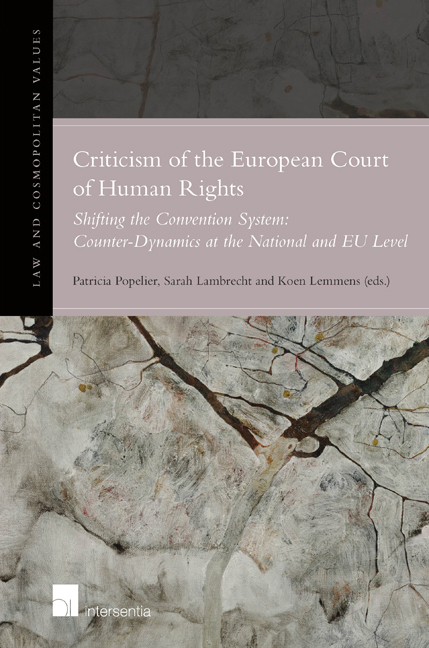 Criticism of the European Court of Human Rights
Criticism of the European Court of Human Rights from PART I - INTRODUCTORY
Published online by Cambridge University Press: 13 December 2017
PURPOSE OF THE EDITED VOLUME
For some time now, the European Court of Human Rights is under substantial pressure. From a case overload crisis it stumbled into a legitimacy crisis with regard to certain countries. The most severe criticism has been voiced in the UK, where ‘charges against the Court … over the past two years have been unprecedented’. Also voices outside the UK, however, have subscribed to these views. This should be taken seriously, since scholars warn that institutions with eroding legitimacy risk demise or reform. This is exactly what the Strasbourg Court was facing within the reform talks leading up to the Brighton Conference under the UK Chairmanship of the Committee of Ministers of the Council of Europe. Ultimately, however, the Brighton Declaration advanced for the most part a technical reform. It is therefore unlikely that the Brighton Declaration and the ensuing Protocol No 15 will be able to tone down opponents of an activist European Court. The Court will thus very carefully need to maintain the difficult balance between human rights protection and respect for national sovereignty.
The goal of this volume is to explore how widespread this critical attitude of the European Court of Human Rights really is. Secondly, the volume assesses to what extent such criticism is being translated in strategies at the political level or at the judicial level and brings about concrete changes in the dynamics between national and European fundamental rights protection. These questions have so far remained largely unexplored, especially cross-nationally. Therefore, the focus is not solely put on countries that are known to have highly critical voices and that, particularly in the case of the UK, have been heavily documented. Rather, we aim to evaluate whether a change in dynamics is a pan-European reality or merely limited to a few countries.
For this reason, our coverage is wide, compromising fifteen Contracting Parties and the EU, as a future Contracting Party. Every in-depth report is based on the same structured questionnaire, which can be found in the annex. The authors also followed the same chapter template which coincides with the questionnaire, as to encourage easy comparison for the reader.
To save this book to your Kindle, first ensure [email protected] is added to your Approved Personal Document E-mail List under your Personal Document Settings on the Manage Your Content and Devices page of your Amazon account. Then enter the ‘name’ part of your Kindle email address below. Find out more about saving to your Kindle.
Note you can select to save to either the @free.kindle.com or @kindle.com variations. ‘@free.kindle.com’ emails are free but can only be saved to your device when it is connected to wi-fi. ‘@kindle.com’ emails can be delivered even when you are not connected to wi-fi, but note that service fees apply.
Find out more about the Kindle Personal Document Service.
To save content items to your account, please confirm that you agree to abide by our usage policies. If this is the first time you use this feature, you will be asked to authorise Cambridge Core to connect with your account. Find out more about saving content to Dropbox.
To save content items to your account, please confirm that you agree to abide by our usage policies. If this is the first time you use this feature, you will be asked to authorise Cambridge Core to connect with your account. Find out more about saving content to Google Drive.